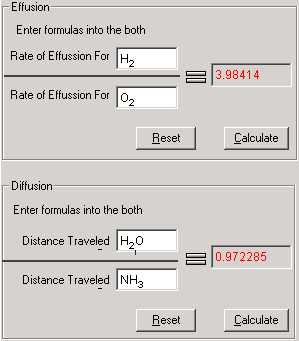Effusion is the term used to describe the passage of a gas through a tiny orifice into an evacuate chamber. Diffusion is the term used to describe the mixing of gases.
The relative rates of effusion of two gases at the same temperature is given:
Rate of effusion for gas 1 / Rate of effusion for gas 2 = square root (M2) /square root (M1)
The relative distances traveled of two gases is:
Distance traveled by gas 1 / Distance traveled by gas 2 = square root (M2) /square root (M1)
where M1 and M2 represent the atomic or molecular weights of gases.
The force exerted per unit area of surface, typical pressure units are ATM, mmHg and kPa.
The measurement of space taken by a substance, it is length cubed, typical units are L, mL and m3.
A measure of the average kinetic energy of the particles in a sample of matter, expressed in terms of units or degrees designated on a standard scale. Typical units are K, F and C.
The mass of the object divided by its volume. Typical units are g/mL and kg/m3.
The formula weight of a compound is the sum of all the atomic weights of the elements present in the formula of the compound. Some text also refers it to formula mass. Typical unit is g/mol.
Mass is the amount of a substance in grams, also called weight.
The constant that appears in the ideal gas equation (PV=nRT). It is usually expressed as 0.08206 L x atm/K x mol or 8.314 J/K x mol.
The number of moles of solute dissolved in one kilogram of solvent.
The number of moles of solute in one liter of solution.
This module is to compute the relative rates of effusion of two gases at the same temperature or the relative distances traveled (diffusion) of two gases by their molecular weight.
In addition to the problem solving module, the "Show Work" is also displayed along with the solution to illustrate the step-by-step guide in how your problem has been solved.
This is two- step process, enter the known data and press Calculate to output the unknowns for each process
1. Select Graham's Law of Diffusion and Effusion link from the front page or Effusion/Diffusion tab from the Gases module.
2. To calculate the Effusion, enter the formulas for the both gases in the boxes. Click Calculate.
Refer to the instruction below in how to type in formula.
3. To calculate the Diffusion, enter the formulas for the both gases in the boxes. Click Calculate.

4. The Show Work area on the right shows you step-by-step how your problem has been solved.
To start a new problem, click Reset. All Input fields will be cleared. Follow Step 1-3 again.
In this program, entering text for molecular formula and chemical equation is rather straight-forward with relatively free style. The program follows chemist's rules, as appeared in chemistry text books. Here are the detailed instruction for entering a formula:
Formula is input as is, element symbols should start with capital letter and follow by low-case letter if dual-letter elements (e.g. for sodium, Na is correct, but NA, nA or na is not acceptable).
Subscription or superscription is entered by typing the upper(subscript)/lower(superscript) arrow keys on the keyboard.(e.g. for SO42-, the keystroke sequence is <S>-<O>-<Down-Arrow>-<4>-<Up-Arrow>-<2>-<Up-Arrow>-<->.